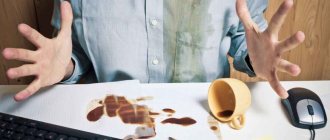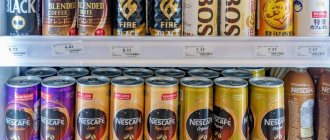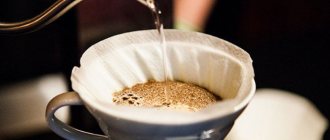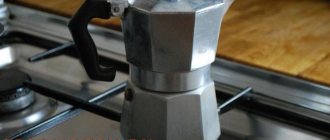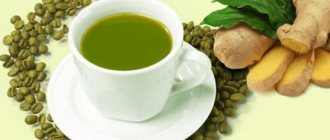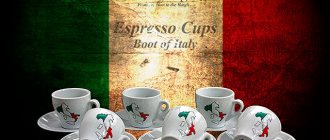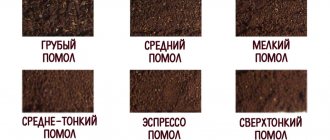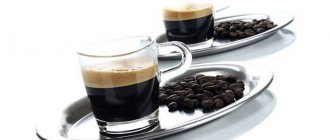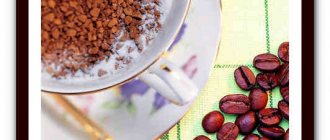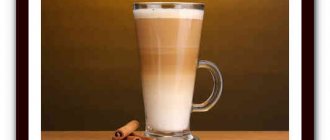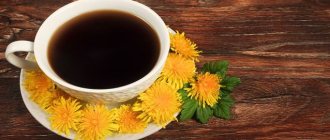There are quite a few ways to brew coffee. Some border on super-scientific tasks and require serious technical equipment, for example, a modern multifunctional coffee machine, while others are considered classics and require nothing more than Turks and creative inspiration. Preparing an invigorating, aromatic drink in a pour-over is considered a low-tech method, but the results are very surprising.
Enjoy your coffee!
And remember that there is always room for experimentation - try different grains, change the grind size, change the water temperature, or try putting a couple of ice cubes or frozen fruit slices in a cup, this will give the drink a special sweetness. Try an alternative recipe called Pour Over Coffee. Making coffee in the Hario V60 is similar to any other pour-over machine, such as a Chemex or Drip coffee maker, you will find their recipes in our articles.
What is pour over
In English, pourover is translated as “pour from above.” These words accurately describe the method of preparing a coffee drink. Hot water is poured through a funnel with ground grains placed in a paper filter. The principle is in many ways similar to the Chemex.
This method of brewing coffee was invented in Japan in 1908. The second name of the pourover is Hario. It is the Hario company that produces specialized cookware that allows you to use this method. The Japanese company produces various types of coffee makers and has an excellent reputation. Therefore, it has earned the trust of coffee lovers.
How to brew coffee using this method
Making coffee in a pour over is quite simple. For this purpose, you need to perform a number of manipulations:
- Secure the funnel to a cup or serving teapot.
- Insert the filter bag into the dripper.
- Heat the water. The optimal temperature is considered to be between 92–95 degrees.
- Slowly, using circular motions from the edges to the center of the dripper, wet the filter. This will eliminate the unpleasant papery taste and warm the container into which the finished drink will be poured to the desired temperature.
- Place ground coffee beans into a moistened filter bag at the rate of 9 g of coffee for every 100 ml of liquid.
- Slowly pour water into the filter, moving from the edges to the center.
- Remove the paper filter and carefully remove the funnel from the serving teapot or regular cup.
Immediately after completing these steps, you can enjoy the taste of the prepared drink.
Pour over is a simple method of brewing coffee beans. When using this Japanese technology, it is possible to prepare amazingly tasty and aromatic coffee. The main thing is to carry out all actions strictly according to the instructions and choose a quality product.
Beginner's set
Coffee prepared in this way has a rich and strong taste. It is similar to European espresso. Connoisseurs will definitely note the similarities between pour-over and Chemex. But the Japanese device uses a finer grind, and the engineering solution itself is distinguished by its signature Japanese simplicity and restraint.
What does someone who decides to make pour-over coffee need?
- Funnel for coffee (dripper).
- Experts recommend purchasing ceramic, although there are plastic options that are significantly cheaper. You can choose a reasonable compromise - a glass dripper. It is inexpensive, and completely safe for health, since it is made from natural raw materials.
- Filter bag for coffee. You can buy regular filters that are used in drip coffee makers, or you can also buy specialized devices for pour over.
- Cup or coffee pot. The finished drink should flow into it.
- For personal use, a regular cup is suitable; for a large company, it is better to use a larger vessel.
- Water kettle.
- You can use a standard heating device, but it is better to try to get a special pour-over kettle. He will ensure that all the details of the process are observed.
- Fine ground coffee. You can take grinding for cezve.
Once you have the necessary kit, feel free to start preparing the drink.
Dishes for pour over
To brew coffee beans in a pour over you will need:
- kettle;
- funnel;
- filter packages.
It would be a good idea to additionally purchase a serving teapot.
Funnel
The dripper (funnel) is the most important item for brewing coffee. In its lower part there is a fastening, thanks to which it is fixed on the brewing flask or cup. Product sizes vary, but the most popular is marking 02. This funnel is suitable for any container.
The dripper is made of plastic and ceramics:
- Plastic models are inexpensive, considered durable, and are often used as test material. They are purchased to evaluate this method of preparing coffee drinks.
- Ceramic funnels are more expensive, but for regular use it is recommended to give preference to them.
Convex lines are applied on the inside of the dripper. Water slowly flows down them, heated to the desired temperature. Thanks to this, it is possible to achieve uniform extraction. According to the Japanese, a drink prepared in a funnel acquires excellent taste and aromatic qualities.
Kettle
A pour over kettle greatly simplifies the brewing procedure. It is equipped with a curved thin and long spout. Water is supplied from it under the required pressure and pressure. The stream is uniform, thin and even. Due to the small diameter of the spout, the liquid does not flow out too quickly.
Various teapots are produced. They differ in volume and design. There are electric and intended for use on the stove.
Serving kettle
Ceramic or glass is used to make this cookware. Branded models are equipped with a special fastening ring, thanks to which the funnel is securely fixed. The kettle is easy to use, simplifies the brewing procedure, but is not considered a mandatory item. Instead, you can use a cup.
Filter packages
It is extremely important that filter bags are made of multi-layer paper. Otherwise, they will not withstand pressure and high temperature. As a rule, they are produced in packs of 40 to 100 pieces. They are intended for single use. Upon completion of the cooking process, the bags are immediately thrown away.
Hario V60. Pour over, or why I bought a cup without a bottom.
Greetings to everyone who is interested in this device. In the review, I will share my impressions of the Hario V60 purover and tell you why it is actually needed. Pour over increasingly catches my eye in everyday life (in stores, coffee shops, the Internet...), and with this bottomless cup, few people can be surprised. For those who are not yet familiar with pour-over, I’ll reveal the intrigue: it is needed for brewing coffee. So why did I buy it? Introduction.
I love drinking coffee (but I don’t like washing dishes), and I have no difficulties preparing and drinking this drink at home. I already wrote more about this in the review of the Hario MSCS-2TB coffee grinder. However, making coffee at work is a completely different matter. In general, in the working kitchen there is an automatic coffee machine of the mid-price segment, but I don’t risk drinking coffee from there, because... It is washed and cleaned only on “holidays,” and this holiday is not always annual. And the employer does not sponsor the purchase of coffee, so the beans used there are those that employees would not mind buying for work, including flavored coffee, which I have an extremely negative attitude towards, and completely cleaning the coffee machine from it is not an easy task. I’m not even talking about freshly roasted coffee. In short, I came to terms with the fact that a coffee machine is a collective property, and the collective decides how to use it. Therefore, for the last five years, at work, I have been brewing coffee in a French press. I was completely satisfied with the taste and simplicity of the brewing method. However, I have already mentioned my dislike for washing dishes. I don’t even like washing a French press; washing the filter mesh is very inconvenient, especially at work (there is no wife to whom I can delegate this honorable duty). This is what motivated me to find a solution to my woes.
Chapter 1. Theoretical.
So, I outlined the problem in the introduction, now I turn to its solution. While researching alternative methods of brewing coffee, I came across pour over. Pour over (English pour over - pour from above) is the name of both the method of brewing coffee and the brewing device itself. The method dates back to 1908. and has Japanese roots. The process of brewing pour over is a ritual somewhat similar to the tea ceremony. The advantage of this method is that it helps to draw out all the flavor properties from the coffee bean and feel the fruity and nutty notes. There are also other names for the device: funnel, dripper, hario (similar to a photocopier), V60. During the search, we came across pourovers made of plastic, glass, ceramics, porcelain and copper. Main manufacturers: Hario, Tiamo, Bonavita, Bodum. Also, pour-overs differ from each other in the number of servings of the drink prepared at a time, the maximum that caught my eye was a pour-over for six cups.
So, I will not describe all the agony of choice here, but I will try to briefly and reasonably explain my choice. First, I decided on the manufacturer. Hario is the most widely represented manufacturer of funnels, you can buy their funnel in almost every local coffee shop, and in general, the name Hario has become a household name for all pourovers, like Xerox for all copiers. Secondly, I decided on the funnel material. The choice fell on plastic due to its greater resistance to external influences from me, my colleagues and the environment. Hario plastic funnels come in three sizes: 01 (1-2 cups), 02 (1-4 cups), 03 (1-6 cups). My choice fell on 02, since funnels of this size turned out to be the most inexpensive. Then I decided on the color, the choice fell on red, as it would be the least easily soiled (after all, it would still need to be washed). The full name is Hario V60 Coffee Dripper 02 / Red (PP). This is how carefully I choose all kinds of cheap nonsense.
On ebay, the selected funnel cost about $11, to check, I went to a couple of local “coffee boutiques”, there I asked if they had a pourover/dripper/funnel (in that order) to which I received a negative answer, then I looked around and saw the product I was looking for at a price of 1200 rubles (about $20), asked: “How can it not, there’s a funnel on the shelf?”, to which he received the answer: “Man, it’s a hario!” Deciding that they didn’t deserve my money, I ordered a funnel and filters for it on ebay (the filters in the local store also turned out to be more expensive, they cost a little less than $15 for 100 pieces, on ebay they cost a little less than $7).
Chapter 2. Practical.
The Japanese sent the goods quickly, and after a couple of weeks I received a funnel (now the seller has run out of plastic funnels, I provided a link to a similar product) and filters, in different envelopes. This is the third time I have ordered filters, they always arrive quickly, in less than two weeks. There are no complaints about packaging and delivery. There was no tracking number.
The first package, packed in a branded box, contained the funnel itself, a measuring spoon and various pieces of paper. The second envelope contained filters packed in a branded transparent bag. The seller included an origami paper crane in each envelope. Funnel dimensions: width at the widest part 137mm, diameter 116mm, height 102mm, weight 84g.
Next, I will describe my general impressions of the product.
The funnel itself is monolithic, without any odor, looks like a cup, with a handle, a skirt at the bottom, without a bottom and winding volumetric lines inside, going from top to bottom. On the funnel there was a sticker with the Good Design Awards symbol (by the way, the symbol is very similar to the Grammar Nazi symbol, or vice versa). Included with the funnel is a measuring spoon with graduations of 8-10-12g (graduation approximately corresponds to reality, I checked). At first glance, the filters are the most ordinary, paper, in the shape of a cone (if you straighten them), with a seam. I was pleased with the quality of manufacturing of all components and packaging. Additional photos. Funnel, measuring spoon, filters.
Now more details. We will need: 1. Funnel. 2. Filter. 3. Freshly roasted coffee. 4. Water (with mineralization in the range between 75 and 250 mg/l). 5. Scales/good eye. 6. Kettle. 7. Cup (or any other vessel on top of which you can place a funnel). 8. Clock/stopwatch/good internal sense of time.
- Turn on the kettle. While the water is boiling, grind the coffee (15g per 220ml serving). The grind needed is quite coarse, a little coarser than for a geyser coffee maker, and a little finer than for a French press. The size of the coffee particles should be similar to the size of granulated sugar particles. I strongly recommend using a burr coffee grinder, because... Grinding uniformity greatly affects the taste of the finished drink. I don’t have the opportunity to grind coffee at work, so I have to grind coffee at home for future use, about 80g. It lasts me 5 days, I drink one cup a day.
- Then I take a cup, place a funnel on top, straighten the filter, bend the seam, and put the filter inside the funnel. I evenly moisten the filter with boiling water (this way it expands completely and fits tightly to the inner walls of the funnel, plus the paper dust is washed off and the funnel heats up). I drain the water from the cup.
- I pour coffee into the funnel and level it a little with a spoon, forming an even plane (some recommend making a small depression in the center), but not compacting it. For one serving of 200-220 ml, I take about 15 g of coffee (experts recommend sticking to the coffee/water ratio = 1/17). After all these movements, the water in the kettle has time to cool to the desired temperature (the same experts recommend using water at a temperature of 92-96 degrees).
- Now pour a thin stream of water from the kettle into the funnel, slightly wetting the coffee, then stop and wait 30 seconds (for a 220 ml serving, at this moment we pour about 40 ml of water). At this stage, if the coffee is freshly roasted, you can see how bubbles of carbon dioxide are formed, which come out of the coffee pulp (the same ubiquitous experts, this process is called flowering).
- Then slowly add the missing 160-180 ml of water, moving in a spiral from the center of the coffee porridge to its edge. Under no circumstances should we pour water onto the walls of the funnel, otherwise the water will spill past the coffee and the result will disappoint you. It is necessary to pour water slowly, not allowing the overall level to rise by more than 2 cm relative to the original one. This process takes me about two to two and a half minutes (experts recommend doing it in two).
Photo.
Photo.
Photo.
Photo.
Photo.
If the water pours out too quickly, then either the grind size is too coarse or you are pouring it onto the sides of the funnel.
If the water does not have time to flow, or stagnates and does not flow at all, then the grinding is too fine or uneven (hello to knife coffee grinders). There is also a possibility that you are pouring water too fast/slow. In short, if it doesn’t work out, then it’s your own fault). So, while I throw out the filter and rinse the funnel, the coffee has time to cool to a comfortable drinking temperature. You can drink. Now a little about the taste of the drink. At first I thought that the result would taste no different from cooking in a French press. But in fact, the drink turns out to be more interesting. The texture of the coffee is buttery, very gentle on the tongue and palate, downright silky. The taste is quite rich, not watery (as is usually the case when brewing in a drip coffee maker). The taste has less bitterness and more additional tones, which depend solely on the Arabica variety chosen for brewing. The drink is transparent, completely free of coffee grains and dust (even after brewing in a French press, there were always particles of coffee dust left at the bottom of the cup). I liked the result so much that I bought the same funnel for my home, and this method has almost completely replaced the Turk in my kitchen.
In fact, there are many brewing methods floating around on the Internet; the coffee/water ratio, pouring time, degree of grinding, and water level in the funnel vary. In general, there is a lot of room for creativity. In the instructions for the funnel itself, the manufacturer recommends taking 12g of coffee per 120 ml of water. I tried it, it turned out very strong, closer to espresso. Now I cook according to the method I described above.
There are also many accessories for making coffee this way. Firstly, the kettle. Hario has a line of teapots with a long curved spout attached to the teapot almost at the bottom, called “Buono”. Their cost starts from $45, I have seen analogues/counterfeits on Ali for $25 and more. They claim that with the help of such a kettle it is more convenient to control the flow rate, and supposedly due to the design, optimal pressure is created for brewing. Perhaps this is so) The line of accessories also includes glass teapots-flasks for serving, which are useful if you prepare several cups at once (at home I use a French press for this). There are also drip stations and other minor things that do not affect the final taste of the drink, but add charm to the entire preparation process.
Conclusion.
So, the purpose of the purchase was to simplify my coffee life at work. And I believe that I have achieved this goal. The main advantage for me is the reduction in time spent washing dishes. I just need to rinse the funnel and throw away the filter, and now I don’t have to spend a lot of time and painstakingly cleaning coffee particles out of the French press mesh filter. Again, the taste of the drink turned out even better than in the French drink, there is completely no coffee suspension in the cup, plus new coffee undertones have been added to the taste (I may be making this up here)). On the downside, it should be noted that new consumables have appeared, you need to make sure that you don’t run out of filters and buy them on time. Consequently, the cost of preparing a cup of coffee has increased. Coffee consumption has remained the same, if you don’t take into account that at work, when they see a funnel, many people ask to make coffee for them too, and now, during the working week, they have to grind more coffee, but my generosity is to blame here). In addition, I began to buy more expensive Arabica varieties, because... With this brewing method, I can more clearly sense the taste differences between varieties; now, even blindly, I can taste some light-roasted varieties.
My coffee corner
PS Now I buy coffee from torrefacto, and in principle I am more than satisfied with everything except the frequency of roasting. Sometimes I don’t have time to keep track and the coffee runs out. For example, on Monday they ran out of coffee, they roast it only on Fridays, delivery to my city is on Thursday, and as a result I have to go without coffee for a week and a half. I found the tastycoffee service, they claim that they roast coffee every day. Has anyone used their services and compared with torrefacto? The presence of flavored coffee in their assortment, as well as uninformative reviews, is very confusing. Or maybe there are other worthy and more efficient services?
Selection of coffee for pour over
Since the drink contains the maximum amount of essential oils compared to other brewing methods, the choice of coffee for pour over is of great importance. Baristas recommend giving preference to freshly roasted single-origin Arabica beans. Arabica blends are also suitable, but blends with even a small amount of Robusta are not suitable: the drink will be bitter.
The roast should be no darker than medium (Viennese), but preferably lighter, grinding should be medium or coarse. When using a Hario paper filter, a slightly finer than medium grind (but not fine) is acceptable. The finer the grind, the fuller the drink will be. But particles that are too small clog the filter pores. In a drink made from coarsely ground coffee, the sourness is more clearly felt.
Water mineralization should be in the range of 70–200 mg/l (optimally 150 mg/l). Chlorinated tap water significantly worsens the taste of the drink.
Pourover kettle and dripper
The main item for brewing pour-over coffee is a dripper (funnel). It is made of plastic, glass or ceramics. It is mounted on a regular cup. A paper filter bag for coffee powder is inserted into the funnel. First lightly moisten the filter with boiling water, and then begin pouring it through the coffee.
You can buy a mobile funnel separately or purchase a set that includes a teapot and a funnel.
The Japanese company Hario , specializing in the production of such cookware, offers a convenient pour-over kettle and funnel Hario V60 .
A distinctive feature of the teapot is its thin, very long, curved spout. It is located in the lower part of the body, which allows you to create the necessary pressure during brewing. The Japanese claim that with such a kettle, even a beginner will brew delicious coffee the first time. After all, the design of the spout allows you to create a stream of optimal pressure and speed. The range includes kettles designed for heating on the stove, as well as electric models.
The Hario V60 funnel looks like this
The manufacturer of pour-over cookware is so popular in Japan that the company's name is sometimes confused with the name of the coffee brewing method, mistakenly calling it Hario.
Hario is a manufacturer of cookware for the spill method. The method of brewing coffee is called pour over.
Dripper is the name of the funnel in which the filter is placed.
What types of coffee are suitable for pour over?
You can brew any type of coffee in the machine, it depends on personal preferences:
- Bright varieties from Africa, such as Kenya, Ethiopia, Uganda, are ideal for those who like to stretch out the coffee ceremony and enjoy the drink for a long time.
- Strong and sour varieties, for example, India or Colombia, will appeal to connoisseurs of espresso and other invigorating coffee options.
- Central American options, like Nicaragua, Costa Rica, Honduras, are ideal for those looking for a golden mean. This is a universal solution for people who appreciate the bright, interesting, but not very strong taste of the drink.
Does pour-over coffee taste better?
It depends on what kind of drink you like. Honestly, we think the way you measure your coffee and grind your beans also has a big impact on the taste.
Pour-over fans insist that this method – especially if you do not use a paper filter – gives the drink a more natural taste. The fact is that paper filters are so good that they do not let oil into the mug.
Whether the pour over method makes coffee taste better is controversial. To get the answer, it is best to try this method yourself.
What really brightens up the beginning of the day is the pleasure of the brewing process, trying new rituals for a morning cup of coffee. Caffeine is associated with frantic mornings or stressful nights, so it's worth slowing down and enjoying your drink.
Secrets to making the perfect pour over coffee
Any variety can be brewed in the hario; here you should pay attention to the grinding for the pour-over - it should be medium or coarse, because fine grinding can pass through the funnel and spoil the impression of the finished drink. The amount of aromatic powder for such coffee is taken at the rate of 60 grams per 1 liter of boiling water. A standard 250 ml mug will require approximately 15 grams of coffee. To make the drink truly perfect, it is better to use a kitchen scale.
For you:
Management accounting in a coffee shop, DDS table
The water for preparing the drink should not be too hot. It is better to boil the kettle and let it cool for 2-3 minutes. The optimal temperature is from 92 to 95 degrees.
Before pouring coffee into the filter, it is recommended to rinse the filter with a small amount of hot water. This little trick will remove any possible off-flavors.
Factory roasted coffee loses its taste and aroma over time. To fix this, you can pre-wet the coffee - before pouring the powder into the filter, add just a little water to it. The coffee should have a mushy texture. After this, you should wait 2-3 minutes and transfer the substance to the filter.
Water is poured in a very thin stream and in uniform circular movements clockwise. After the filter is removed, you can shake the drink slightly. This is necessary for better saturation of the coffee with air.
Japanese method of brewing coffee
After coffee began to assert its rights more and more decisively in Asian markets, the Japanese began to think about their own method of preparing the drink. At the very beginning of the 20th century, a brewing method called strait . Its essence was a little like making tea. The ground coffee was poured over with a slow and steady stream of hot water. The biggest trick was to choose the optimal pressure and flow rate of boiling water. The stream should be very thin, it must be poured in a spiral, and the entire pouring procedure should take about 2 minutes.
It is not surprising that the Japanese themselves really liked this method. It is similar to the usual tea manipulations and allows you to concentrate on the process of preparing the drink. Such concentration is highly valued in Japanese philosophy and culture, as it helps to achieve a state of spiritual harmony.
For the time being, this method had fans only in the land of the rising sun. In the mid-50s, one manufacturing company took the idea on board and began producing special utensils for making pour-over coffee. The assortment quickly grew to several dozen items, and now every Japanese person could quickly and easily prepare their favorite drink.
Catering enterprises have actively begun to use such utensils. She attracted the attention of tourists. The British who witnessed this method were delighted and immediately dubbed it the coffee ceremony . Then a second, typically English name appeared - pour over . Its transliteration into Russian gave the term pourover, under which this method is gaining popularity in our country.
About five years ago, pour-over entered the States and won the hearts of curious Americans, traditionally partial to all sorts of exotic things.
Around the same time, pour over reached the European part of the continent and today it can be freely purchased in many coffee shops in our country.
Electric pour over coffee maker
Not long ago, information appeared that one of the companies released an electric pour-over coffee maker that prepares coffee according to the Japanese method.
There is only one brand of pour over coffee maker, KitchenAid . Brand and country of origin: USA.
Photo of pour over coffee maker KitchenAid 5KCM0802EOB
They slightly changed the principle of drip coffee makers. In the device, water is supplied through the coffee in a continuous stream, the thickness and flow rate of which is controlled electronically. All processes are fully automated, right down to filter washing and container heating. The supply water temperature is 93°C. The manufacturer managed to develop an electronic device that reliably repeats all the processes of manual brewing using the pour-over method. Cost - about 25 thousand rubles.
This coffee maker is not yet very widespread among Russian consumers, and there are no real reviews about the quality of the finished drink.
